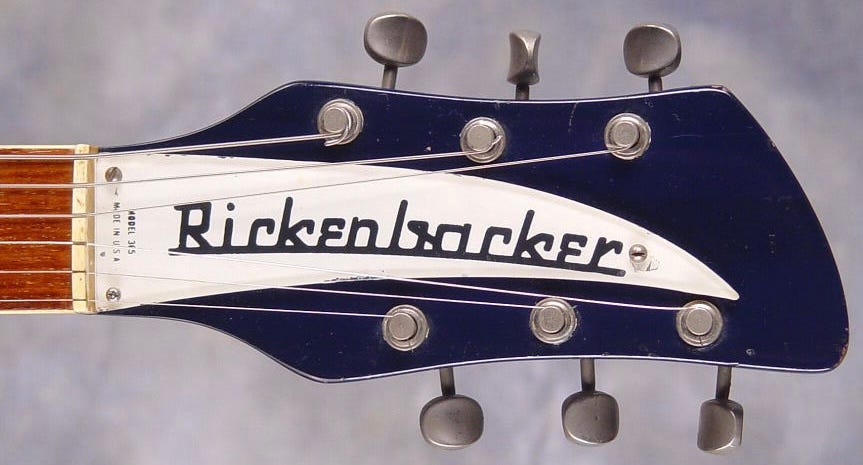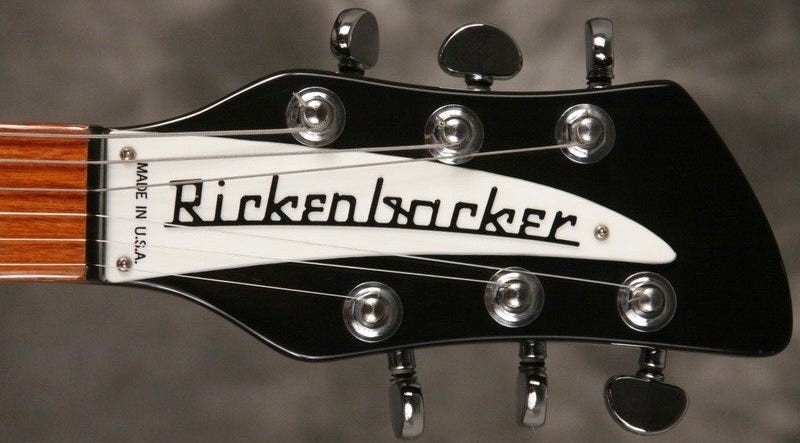Terminology: The Gumby Headstock
In any discussion of 6-string 360s from the 1970s and early 1980s you will come across the term “Gumby headstock”—that design element is a defining characteristic of the era. And while that design is somewhat polarizing, once you understand the “why” of it, you will realize it IS a purposeful design…even if it may look a little bit like Gumby. Let’s get into it!

So first things first: what is a “Gumby”? Gumby is a character created by Art Clokey in 1953. Clokey produced a series of stop-motion “claymation” shorts featuring Gumby for the Howdy Doody show in 1955, and in 1956 Gumby got his own children’s show on NBC that would last until 1969 and live on for years afterwards in syndication. In 1988 the character returned in animated format, and has appeared in multiple places since. He’s a bit of a cultural icon in the US.
So that’s what a Gumby is. So why did we name a headstock after him? I’m afraid we have to talk yet again about the turbulent early 70s era at Rickenbacker, but we’ll do the Cliffs Notes version this time: music gets heavier so everybody wants that Les Paul through a dimed Marshall sound, Rickenbackers are the exact opposite of that so nobody wants them, gotta try and adapt so 24 fret necks, Higain pickups, yadda yadda yadda. You’ve heard this all before.
But here’s a piece we don’t usually talk about: Kluson Deluxe tuners—the default tuners on more or less all Rickenbacker guitars since the early 60’s—kinda suck. We don’t say it out loud often, but we all know it’s true.

I mean look, they were great for the late 1940s when they were invented—groundbreaking, even—but Kluson really didn’t make any significant improvements to the design after the mid 1950s. And other manufacturers like Grover, like Schaller, like even the Japanese, just kept on innovating while Kluson…just kept on making the same tuners.

So in their quest for relevance, in addition to the aforementioned 24 frets and Higain pickups Rickenbacker decided to further update their flagship guitar—the 360–with the “best” tuners currently on the market: Grover Rotomatics.

Bur there was a problem with the Rotomatic: it was bigger than the Kluson Deluxe. A bigger shaft size and bigger bushings and bigger trim rings—they would just barely fit on the existing skinny “vintage” headstock and it looked crowded and kinda goofy. Plus which, given the size of the truss rod cover, the larger trim rings forced the tuners away from the center of the headstock and towards the edge, putting screw holes into the headstock wing joints and creating potential areas of weakness/failure. So what to do?

Enter the Gumby headstock in 1971. The headstock was widened about a half inch, the corners got rounded off a bit, the truss rod cover got slightly shortened, and now the new tuners fit just fine.

To make the change more obvious, let’s look at the “before” and “after” side by side with two 1971 360s (bear in mind bound headstocks would only last about a year):
Does the new one look a little bloated? Yeah, it does. Are the Grover trim rings really big compared to the Klusons? Absolutely. Is the whole “effect” less “pleasing to the eye” than the original? Most folks seem to think so, yes. And it kinda looked like…Gumby.
But the design fixed the problem, what was done was done, and this headstock would appear with Grover Rotomatics on the 360 until mid 1984 when a NEW “less than aesthetically pleasing” headstock would take its place—the so called “paddle headstock. And even WB models got the Gumby during this period, although a handful of 360WB guitars from this era with vintage headstocks DO exist.

If we’re being honest, the “paddle” headstock that followed the Gumby looks more like the actual Gumby than the “Gumby” headstock does, but it was too late. The name was already taken.
The most famous—probably the only famous!—Gumby 360 out there is Peter Buck’s 1981 Jetglo 360 that was his primary guitar for most of R.E.M.’s career and remains his go-to to this day.

And that’s the story on the Gumby headstock!



I was wondering where that first 365 "vintage" headstock shot was from, first thought Jetglo but - no - 365 Azureglo 68 on my mind!